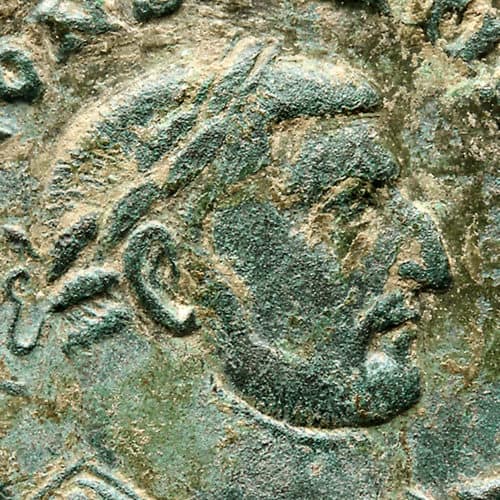Romans activity 8: design a big Roman coin
Investigate Roman coins using Learn with Objects Romans 9: coins as your starting point.
The children research all the different things coins can reveal about the Romans, and why they are so important to the dating of archaeological sites.
They experience buying and selling goods at a Roman marketplace and have fun creating a big Roman coin, with a profile of themselves (or a classmate) as Emperor.
Image copyright: Canterbury Archaeological Trust
Learning objectives
Increased knowledge and understanding of archaeology and Folkestone Roman Villa.
Research skills.
Skills and confidence in role play, drama.
Curriculum links
KS1-2 History (Romans, Local History Study).
KS1-2 English (speaking and listening, script writing, role play, drama)
Investigate the photo of the bronze nummus coin at Learn with Objects Romans 9: coins.
Ask the children the following questions:
- What is it?
- What was it used for?
- What’s it made from? (bronze)
- Was it valuable?
- What were more valuable Roman coins made from? (gold and silver)
- Whose head is on the front? (the Roman Emperor)
- How do we know he is important? (wearing laurel wreath)
- Can you read his name on the inscription? (CONSTANTIVS)
- What was on the back of Roman coins? (Roman gods and goddesses and lots of other things too!)
The children research more widely about what coins reveal about the Romans, and why they are so important to the dating of archaeological sites (if we know when coin was issued we know that level of the site dates roughly to that time).
Look at the following websites:
https://www.historic-uk.com/HistoryUK/HistoryofBritain/Roman-Currency-in-Britain/
https://www.timetrips.co.uk/rom-art-romcoins.htm
Here’s a good guide to identifying Roman coins
https://finds.org.uk/romancoins/
Role play: Roman marketplace
Set up a bustling Roman marketplace, with small groups of children in costume, running different stalls, and buying and selling goods using replica Roman coins.
Children can make their own items for sale, inspired by examples in the Learn with Objects Romans topic, including jewellery, pots, oil lamps, toys and games, bathing accessories, imported spices, food and wine.
Art project: Make a big Roman coin
- Children research and choose a Roman coin design, either from one of the coins discovered on the Folkestone Roman villa site or from the wider collection at Folkestone Museum (Top tip: there are some excellent Roman coins with women on them. Google 'Roman Empresses on coins' for examples)
- Children draw a profile of themselves or a classmate to fill the coin (leaving a thin border for the inscription around the outside).
- Add a laurel wreath to show you are Emperor or Empress
- Add a fashionable Roman hairstyle and/or beard
- Add armour if you want to look like a powerful leader
- Write a Latin inscription in Roman capitals around the outside including your name as Emperor.
- Romanise modern names by adding VS at the end for boys and A at the end for girls. Or choose a new Roman name.
- Colour or paint your coin in to make it look like bronze, silver or gold. Leave bits white where there are highlights, and shade bits darker where there is shadow. Or children could roll up and stick on small pieces of silver foil to make your coin more 3D. This can be used for areas like the inscription, the laurel wreath, the eye brow, the hair and/or beard.
If time allows, create a reverse design as well. A Roman god or goddess, a gladiator fight, the Colosseum, a Roman ship, an imperial eagle… the list is almost endless!

